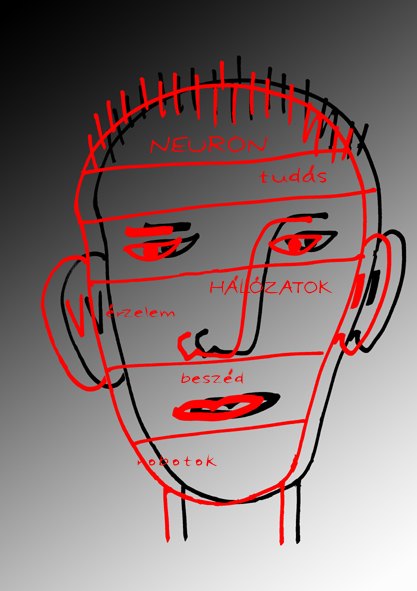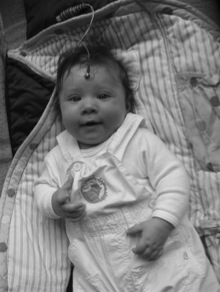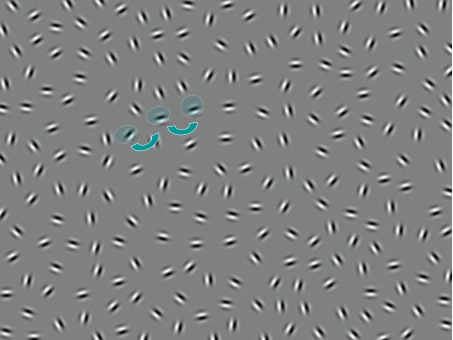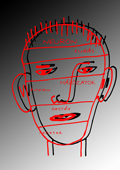 |
BMe Research Grant |

|
As submitted in October 2010
Faculty of Sciences
Department of Cognitive Science
HAS-BME Cognitive Science Research Group
PhD School in Psychology
HUMAN COGNITION
 Cognitive Science is a novel way of investigating human knowledge
and cognition, based on three complementary approaches: (1) Formal
analysis of knowledge (perception, language, memory) relying on the
traditional disciplines of mathematics, philosophy and linguistics. (2) Analysis
of biological systems (that embody cognition) by the
experimental investigation of real biological cognitive systems, evolution
of these systems, their neural organization and disturbances. (3) Analysis of
cognition in terms of artificial systems.
Cognitive Science is a novel way of investigating human knowledge
and cognition, based on three complementary approaches: (1) Formal
analysis of knowledge (perception, language, memory) relying on the
traditional disciplines of mathematics, philosophy and linguistics. (2) Analysis
of biological systems (that embody cognition) by the
experimental investigation of real biological cognitive systems, evolution
of these systems, their neural organization and disturbances. (3) Analysis of
cognition in terms of artificial systems.Cognitive Team within the BME:
Members of the team are affiliated with the
Psychology PhD School (since 2004), the Department of Cognitive Science (since
2004) or the HAS-BME Cognitive Science Research Group (since 2007). These three
units were founded by Csaba Pleh (member of the Hungarian Academy of Sciences), and
are composed of young scientists working within the fields of cognitive
neuroscience and psycholinguistics.
MOST RECENT RESEARCH TOPICS
'NATURE'? / 'NURTURE'?
 Binocular vision
(stereopsis) emerges at 3 months of age in typically developing human babies.
Functional binocularity is based on clearly defined anatomical changes within
the visual cortex, such as the development of binocular cortical
neurons detecting retinal
disparities and the formation of ocular dominance
columns. What happens during those three months? Is it a genetically
preprogrammed wiring of the cortex ('Nature') or a
stimulus-defined modification of neural connections ('Nurture')? We attempt to answer this question by
investigating preterm babies who are given two extra months of stimulation on
average. Is it their real or corrected postnatal age that determines the onset
of stereopsis? We employ dynamic noise stimuli with alternat
Binocular vision
(stereopsis) emerges at 3 months of age in typically developing human babies.
Functional binocularity is based on clearly defined anatomical changes within
the visual cortex, such as the development of binocular cortical
neurons detecting retinal
disparities and the formation of ocular dominance
columns. What happens during those three months? Is it a genetically
preprogrammed wiring of the cortex ('Nature') or a
stimulus-defined modification of neural connections ('Nurture')? We attempt to answer this question by
investigating preterm babies who are given two extra months of stimulation on
average. Is it their real or corrected postnatal age that determines the onset
of stereopsis? We employ dynamic noise stimuli with alternat ing phases of
correlation and decorrelation between the two eyes, and register visually evoked
brain potentials (VEP) in order to find an answer. The VEP binocular response
clearly shows that preterm infants make full use of the extra 2 months of
stimulation, and their binocular response is there at 3 months after birth as
well ('Nurture'). This indicates that the human
cortex is much more plastic and stimulus-dependent than we thought before!
This work is carried out in collaboration with Dr. Gabor Jando (Pécs
University), and the paper is under review in Science. We plan to further
investigate whether increased plasticity is due to human-specific learning
mechanisms or to differences in the macrostructure of the cortex by applying
near infrared spectroscopy (NIRS). We are looking for support for purchasing
the NIRS equipment.
ing phases of
correlation and decorrelation between the two eyes, and register visually evoked
brain potentials (VEP) in order to find an answer. The VEP binocular response
clearly shows that preterm infants make full use of the extra 2 months of
stimulation, and their binocular response is there at 3 months after birth as
well ('Nurture'). This indicates that the human
cortex is much more plastic and stimulus-dependent than we thought before!
This work is carried out in collaboration with Dr. Gabor Jando (Pécs
University), and the paper is under review in Science. We plan to further
investigate whether increased plasticity is due to human-specific learning
mechanisms or to differences in the macrostructure of the cortex by applying
near infrared spectroscopy (NIRS). We are looking for support for purchasing
the NIRS equipment.
PI: Ilona Kovács
Books under the pillow?... the story of SLEEP and LEARNING
The HAS-BME Research Group in
Cognitive Science investigates relationship between sleep and learning
with OTKA and NIMH support. Building upon earlier
work of the group leader, the research group is looking at perceptual and
motor skill learning in people living with genetically based developmental
disorders and in typically developing people. As they have shown
before, cortical mechanisms defining fine perceptual discrimination and
motor skill learning take a long time, even decades in humans to become fully
mature. The human cortex is extremely sensitive to environmental stimulation and
epigenetic influences during this long plastic period. It is important to define
all the factors promoting and delaying development because these will help to
encourage healthy development (education), and to correct atypical developmental
directions (medication). People with developmental disorders and mental
retardation pose a difficult burden on society, cannot lead an independent
life, and long-term care of these patients and their families has to be
provided. Our research offers help in two ways: (1) early diagnosis and the
possibility of effective early therapy, (2) improvement of severe problems by
defining epigenetic (e.g., sleep patterns) and behavioral components of the
disorder that can be improved by different medical treatments. Quality of life
in these populations might improve due to the treatments, and they might become independent and self-supporting citizens. In a modern, generally
sleep-deprived society, there are consequences of this research with respect to
the typically developing population as well.

Developmental and learning profiles,
related to the plasticity of the primary visual cortex (V1) and primary motor
cortex (M1) were derived from psychophysical studies of low level visual (using
the contour stimuli embedded
in noise – see illustration) and motor learning. This provides us with the
possibility to predict whether the origin of learning deficits is (1) structural
disorganization of the cortex, (2) sleep disorder, or (3) both. To test our
predictions, we have already started to look at the correlations between
behavioral data and the micropattern of sleep as measured by electrophysiology.
These results paint a very sophisticated picture, going well beyond the idea of
general pervasive learning deficits. We are able to point to specific cortical
mechanisms behind learning problems, opening up possibilities for new therapies.
The results are being published in the Journal of
Vision, Developmental Science and the Journal of
Developmental Disorders. As a next step, we already started to collect
genetic samples in the atypically developing population, and plan using cortical imaging techniques as well (MRI, fMRI, DTI). The amount of
gene-deletion and the location of cortical anatomical changes in particular
individuals might reveal novel functional relationships between genes and
behavior. We are seeking support for the genetic and brain imaging
studies.
PI: Ilona
Kovács
What's talking? Organization of AUDITORY information in the human brain
At the HAS Psychology Research Institute, under
Dr István Winkler's supervision, students of the BME Psychology PhD School carry
out research on auditory perception. One of the outstanding projects focuses on
the sensitivity
of newborn human babies to music. Based on the supervisor's earlier
work, their most recent studies are related to the organization of incoming
sensory information into object representations. The concept of an object is not
so clear in audition. With respect to storage, both the sound source (physical
object) and the sound pattern (melody, speech etc.) are units with object-like
properties (having its own features, can be differentiated from other objects,
can be recognized by its different occurrences and missing information is completed – similarly to what happens in
vision). Moreover, signals from simultaneously active sound sources get
mixed together even before arriving to both ears. In order to solve the
inverse problem, i.e. the problem of object separation, the brain relies on
heuristics that are either inherited or learned during our life. The process of
object separation is usually studied in a simplified ABA-sound sequence, where
'A' and 'B' are two different sounds, and the '-' mark represents a break of the
same duration as a sound. Depending on the difference between the two sounds
and on the pace of presentation, one may perceive a single coherent sound stream
or two parallel streams (sound illustration). It has
been shown recently that with a long exposure (exceeding two minutes) to such
stimuli, there is a parameter-independent switching back and forth between the
two organizations. Because we do not experience such instability in everyday
life, the question is what mechanisms stabilize perception. As a next step, we
plan to compare auditory and visual perceptual organization and include them in
a common model. We are seeking support for the development of the integrative
visual-auditory model of perceptual organization.
PI: Istvan Winkler.
Are there two kinds of schizophrenia?
Schizophrenia is one of the biggest common health problems all over the
world, an illness studied with enormous financial efforts. As the substantial
pathological processes are not clear, there is no causal therapy yet. One of the
essential reasons of the failure of research is that validity of the studied
phenomenal construction is insufficient. At present, the phenotype is signified
by the diagnosis based on clinical symptoms, however, the concept of the
diagnostic systems is oversimplified. Our systematic preliminary studies
carried out in collaboration with the Psychiatric Clinic of the University of
Szeged have identified two clusters within the illness.
Anticipated results
of this project are the development of a phenotype determination method,
international publications as well as manual on the neurobiological aspects of
psychotic mental disorders.
Our basic research can help refining target
determination of etiological studies and development of specific
therapeutic and rehabilitation methods. It can also help identifying
developmental markers that are detectable before the manifestation of psychotic
symptoms.
We are looking for support for building up the Hungarian
genetic bank of patients with schizophrenia. We are also looking for
support for purchasing an eyetracking equipment.
PI: Mihály Racsmány
Is it only language? Learning in SPECIFIC LANGUAGE IMPAIRMENT
Children with Specific Language
Impairment (SLI) have a primary deficit in language abilities in the absence of
any hearing deficits, neurological disorders, emotional and social problems,
environmental deprivation or mental retardation that could account for their
language problems. Although there are claims that in SLI, language is
selectively impaired in an otherwise intact cognitive system, numerous results
show that SLI is often associated with impairments in several nonlinguistic
domains, but the nature, extent and generality of these deficits is yet unclear,
as is their relationship with language abilities. After examining language abilities in
Hungarian children with SLI in detail, currently our research group is
working on testing procedural learning of sequential and nonsequential
information in children with Specific Language Impairment, and aims to study its
relationship with language abilities (both with grammar and vocabulary).
Possible dissociations between mechanisms and domains of procedural learning are
going to be tested by using three different classical paradigms of implicit
learning, Artificial Grammar Learning (AGL), Serial Reaction Time Task (SRT) and
Probabilistic Category Learning (PCL). So far our results show that children
with SLI, unlike their age-matched typically developing peers, do
not show learning in the probabilistic task. This result points to
deficits beyond the language system, and also beyond problems with sequential
organization. Preliminary results also show impaired artificial grammar learning
(based on auditory sentences generated by made-up rules from nonsense
syllables), but preserved learning in learning the sequence of locations in the
SRT task. Further investigations aim at making the mechanisms of learning in the
nonlinguistic domain and their relationship to language clearer.
PI: Ágnes Lukács
Can the computer process METHAPHORs?
One of the key research areas in computational linguistics is the automatic semantic analysis of natural language. An exceptionally difficult problem is processing those aspects of meaning that do not predictably follow from the dictionary senses of words and sentential syntax. It is this problem that our project explores through the corpus-based analysis of literal versus typically abstract metaphorical language use. Our research focuses on the question whether automatic identification of certain conceptual metaphors could be successful taking the processes advocated by the Embodiment Hypothesis as a starting point. 12 widespread conceptual metaphors were selected where consistent mapping was observed between a concrete (source) domain and an abstract (target) domain. According to our hypothesis, a metaphoric sentence should include both source-domain and target-domain expressions. This assumption was tested relying on three different methods of selecting target-domain and source-domain expressions: a) a psycholinguistic word association method, b) a dictionary method and c) a corpus-based method, where the words were manually selected from sentences containing conceptual metaphors. Our results show that for the automatic identification of metaphorical expressions, corpus-based method is the most effective strategy, which suggests that the concept of source and target domains is best characterized by statistical patterns rather than by psycholinguistic factors. To be able to characterize the precise nature of these statistical patterns and the process of metaphor comprehension further experimental and corpus analysis data are needed.
PI: Anna
Babarczy
Outstanding publications
5 outstanding publications over the past 5 years:
- Pléh Cs: A lélektan története (The history of psychology), 2nd ed., Budapest, Osiris, 2010.
- Kovacs I: Hot-Spots and Dynamic
Coordination in Gestalt Perception Ernst
Strüngmann Forum Dynamic Coordination in the Brain: From Neurons to Mind.
MIT Press, 2010.
- Winkler I, Haden GP, Ladining O, et al.: Newborn infants detect the beat in music.
PNAS (USA) 106/7 , 2468-247, 2009
IF: 9,380, Times Cited: 12 - Racsmany
M, Conway MA, Garab
EA, Cimmer Cs, Janka Z, Kurimay T, Pléh Cs and Szendi I.: Disrupted memory inhibition
in schizophrenia. Schizophrenia Research 101/1–3, 218–224, 2008
IF: 4,260, Times Cited: 5 - Lukács Á.: Language Abilities in Williams Syndrome. Budapest, Akadémiai. 2005.
5 outstanding papers published before 2005:
- Naatanen R, Winkler
I: The concept of auditory stimulus representation in
cognitive neuroscience. Psychological Bulletin
125/6, 826–859,1999
IF: 10,905, Times Cited: 426 - Kovacs I, Papathomas TV,
Yang M, et al.: When the brain changes
its mind: Interocular grouping during binocular rivalry. PNAS (USA) 93/26,,15508–15511,1996
IF: 10,244, Times Cited: 133 - Kovacs G, Vogels R, Orban GA.: Cortical correlate of
backward pattern masking. PNAS (USA)
92 /12, 5587–5591, 1995
IF: 10.450, Times Cited: 101 - Kovacs I,
Julesz B: Perceptual sensitivity maps within globally defined visual
shapes. Nature (London) 370/6491, 644–646, 1994.
IF: 25,466, Times Cited: 108 - Kovacs I, Julesz B.: A closed curve is much
more than an incomplete one. PNAS
(USA) 90 /16, 7495–7497, 1993
IF: 10.325, Times Cited: 237
The team-members:
 Ilona Kovács, DSc |
 Csaba Pléh, MTA r.
tag |
 István Winkler,
DSc |
 Gyula Kovács, DSc |
||||
 Mihály Racsmány, habil PhD |
 Ágnes
Lukács, PhD |
 Anna Babarczy, PhD |
 Zoltán
Jakab, PhD |
